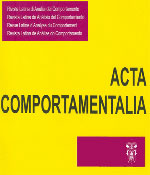Functional types of selector stimuli and delay in matching-tosample wich humans
DOI:
https://doi.org/10.32870/ac.v15i1.14515Keywords:
second-order matching- to sample, delay interval, transfer, adult humans.Abstract
Four groups of college students were exposed to a second-order matching-to-sample task and intramodal, extramodal, and extradimensional transfer tests. Groups differed in the functional type of selector stimuli (instructional or discriminative) and in its temporal relation (simultaneous or delayed) with respect to the remainig matching arrangement during training. The accuracy of the performance decreased with delay but was enhanced by the functional complexity of selector stimuli in training. In transfer tests, performance was higher using the delayed-instructional arrangement, followed by simultaneous discriminative, simultaneous-instructional, and delayed-discriminative arrangements, in that order. Results are discussed in relation to comparable studies, highlighting the functional role of each type of selector stimuli and the delay on the identification of the matching relations.
Downloads
Downloads
Published
How to Cite
Issue
Section
License

<a rel="license" href="http://creativecommons.org/licenses/by-nc-sa/4.0/"><img alt="Licencia de Creative Commons" style="border-width:0" src="https://i.creativecommons.org/l/by-nc-sa/4.0/88x31.png" /></a><br />Este obra está bajo una <a rel="license" href="http://creativecommons.org/licenses/by-nc-sa/4.0/">licencia de Creative Commons Reconocimiento-NoComercial-CompartirIgual 4.0 Internacional</a>.






